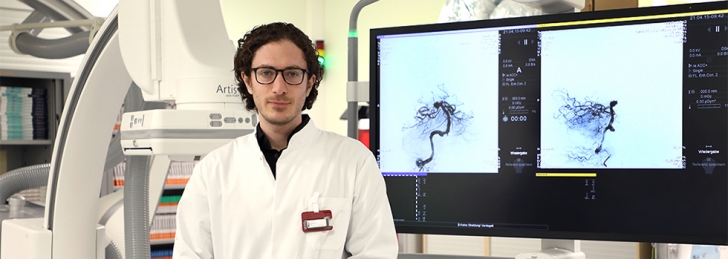Angiography/Intervention
Digital subtraction angiography (DSA)
Angiography is an imaging technique in which contrast medium is applied directly to blood vessels and made visible by means of X-rays. The procedure makes it possible to view vessels in the body and also in the head at the highest resolution. In addition, the image acquisition takes place over a defined period of time, i.e. from the "flooding" of the contrast medium with the blood flow from the heart to the return of the blood to the heart.
As a rule, angiography is performed without general anesthesia, but with local anesthesia of the groin or wrist. The inguinal artery or one of the arteries of the forearm (or at the elbow) is first punctured with a needle, after which a short plastic tube (so-called sheath) is inserted into the vessel. The vessels to be examined are then accessed via a thin catheter and contrast medium is applied on site.
At the end of the examination, the catheter and sheath are removed and a pressure dressing is applied.
You will find concrete information on the preparation and practical procedure of an angiography here.
Stroke Treatment (Thrombectomy)
Severe strokes are particularly often caused by occlusion of a large vessel in the brain. If such an occlusion has been detected by CT, the reopening of the vessel by means of a catheter (thrombectomy) should be performed immediately. Our team is available 24 hours 7 days a week (Emergency Number)to offer the best possible therapy to all patients with severe stroke.
Treatments for vasoconstriction of the carotid artery
High-grade constrictions (stenoses) of the carotid artery cause an increased risk of stroke. In particular, if a mild stroke has already occurred and stenosis of a carotid artery was the cause, treatment should be given to prevent a stroke from recurring. Treatment can be either open surgery or a minimally invasive procedure using a catheter. This involves placing a stent over the narrowing in the vessel and then expanding it with a balloon to improve blood flow.
Aneurysm treatment
Aneurysms in the brain are a relatively common condition, affecting approximately 3-5% of the population. An aneurysm is a blood vessel that can rupture and cause severe cerebral hemorrhage. If a brain hemorrhage has already occurred (so-called subrachnoid hemorrhage - SAB), the aneurysm must be closed as quickly as possible to prevent a new hemorrhage. For the emergency treatment of aneurysms, our team is available around the clock together with our colleagues from the Department of Neurosurgery..
If an aneurysm is discovered by chance, e.g. during an MRI examination of the brain, the first step should be an angiography and a detailed consultation, which also includes an interdisciplinary discussion of each individual case with the colleagues from neurosurgery. If treatment is then to be performed, we offer the full spectrum of all modern minimally invasive treatment procedures.
In minimally invasive (endovascular) treatment of an aneurysm, the aneurysm is accessed via a catheter inserted through the inguinal or brachial arteries and either filled from the inside with platinum microcoils or treated by means of a woven basket (so-called WEB device) or aneurysm neck-bridging meshes (Contour or Neq stent). In addition, for some aneurysms there is a very good treatment method using flow-guiding stents (flowdiverters). The aim of all procedures is to stop the flow of blood into the aneurysm and thus reduce the risk of bleeding.
Treatment of vascular malformations of the brain
Vascular malformations in the brain are rare diseases in which there is a pathological short circuit between blood-supplying vessels (arteries) and blood-draining vessels (veins). This group of diseases includes arterio-venous malformations (AVM or angiomas) and dural arterio-venous fistulas (dAVF). These vascular short circuits can lead to cerebral hemorrhage, and it is true, as with aneurysms, that a vascular malformation should be treated primarily if it has already caused bleeding. In this case, minimally invasive treatment uses a very thin catheter to access the vascular short circuit and usually closes the malformation with a type of liquid adhesive. In selected cases, treatment should also be performed if the diagnosis was made by an incidental finding (MRI/CT).








